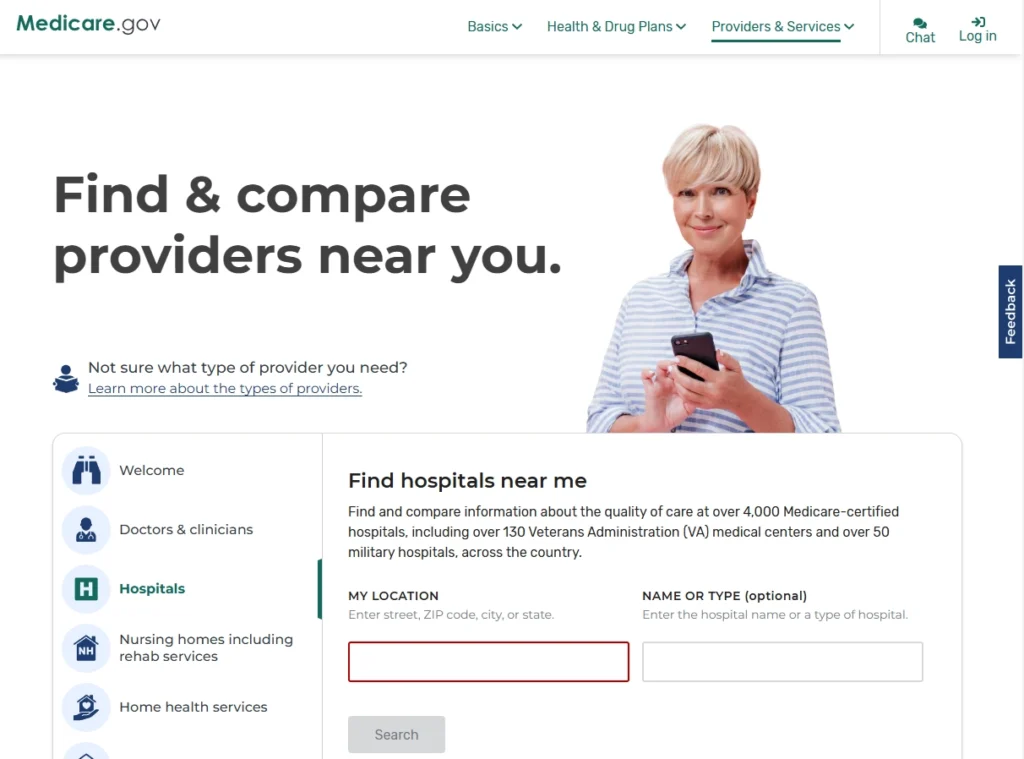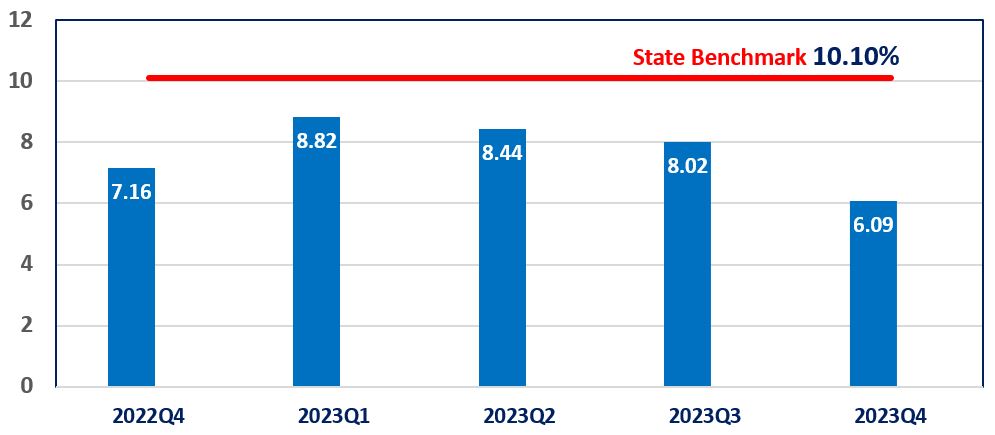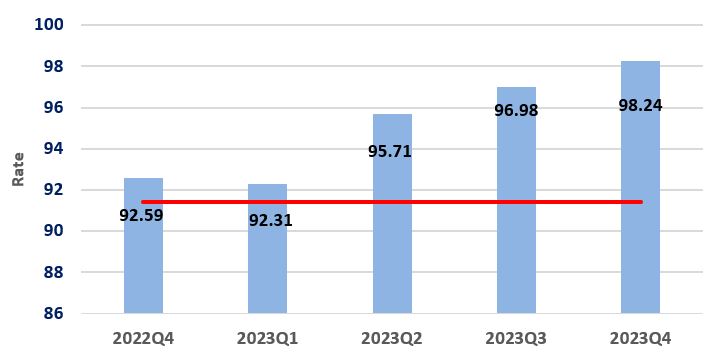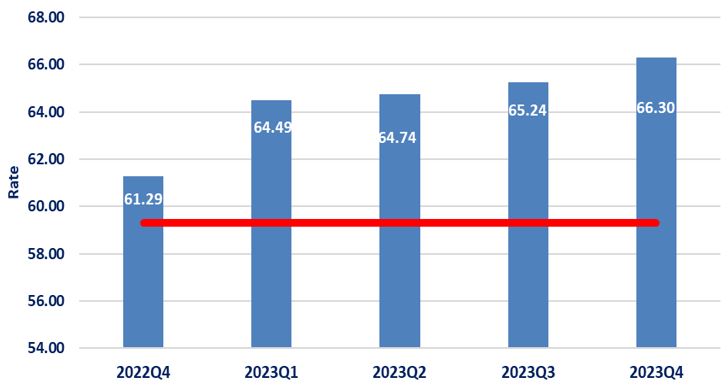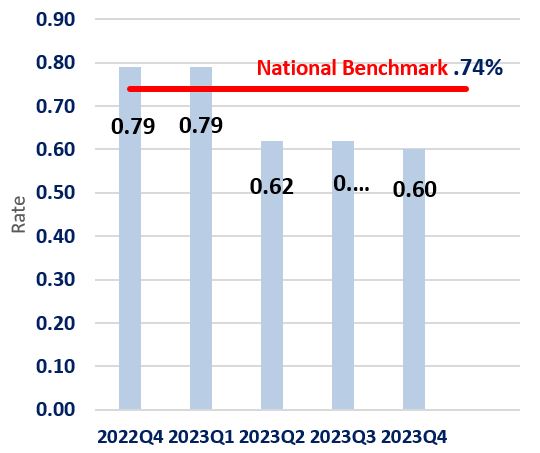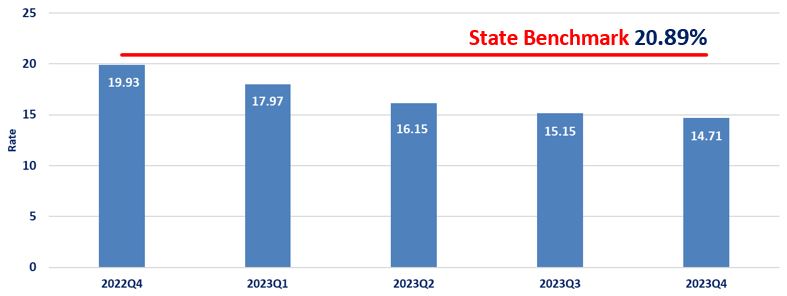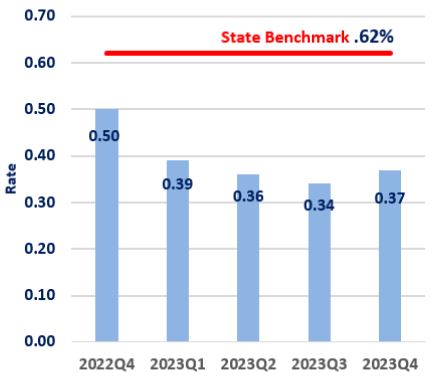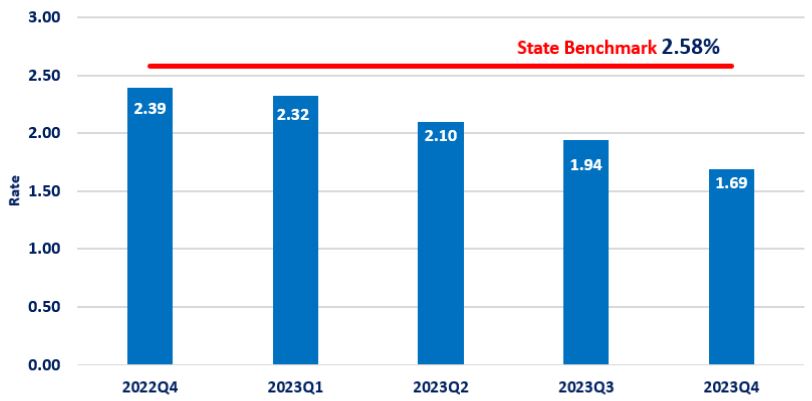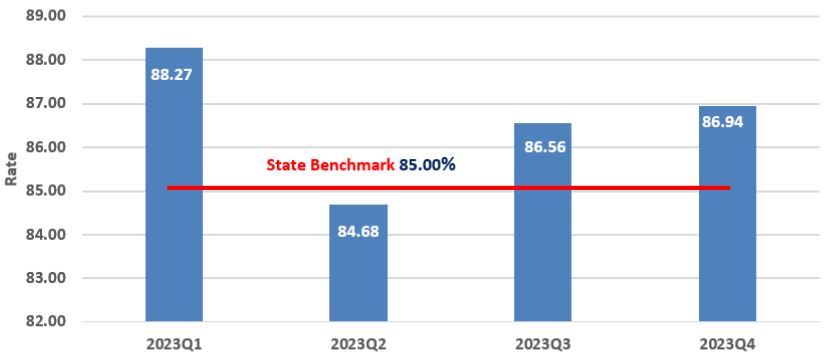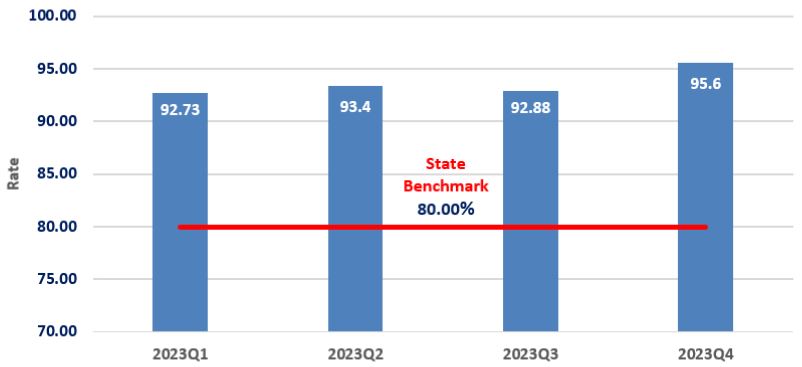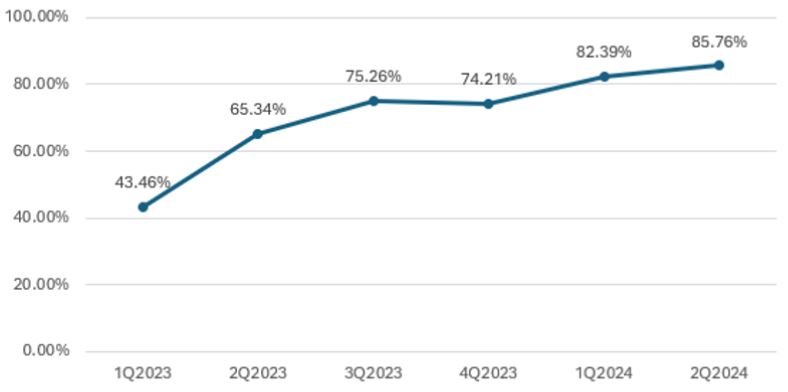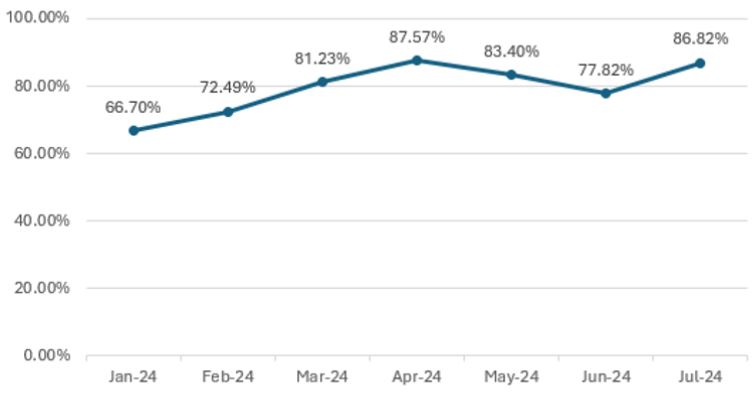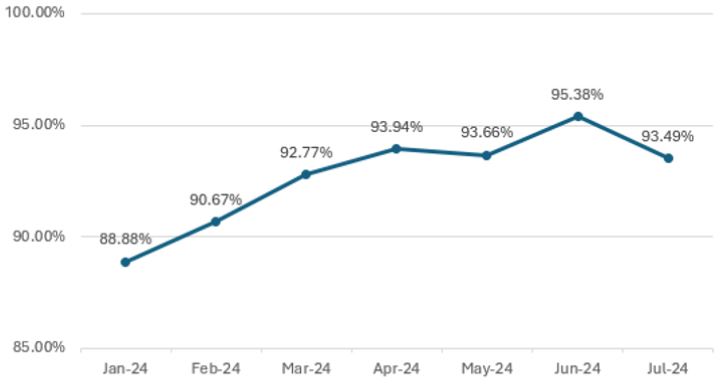Home Quality Data
Quality Data
Care Compare
Care Compare: Patients can use this tool to find and compare different types of Medicare providers (like physicians, hospitals, nursing homes, and others).
Hospital Quality in Kentucky
Kentucky hospitals have successfully improved health outcomes in every measure over the past two years (2022 – 2023):
- 30 day all-cause unplanned readmissions
- Sepsis screening and timely treatment
- Infection Reduction – Catheter associated urinary tract infections and C Difficile
- Opioid Prescribing – multiple opioids at discharge and alternatives for pain management of ankle sprain
Kentucky hospitals have implemented three new screenings for patients and increased referrals to resources:
- Social Determinants of Health
- Maternal Depression and substance use disorder
- Suicide screening in the ED
Medicaid Readmissions
- Kentucky hospitals have reduced Medicaid readmission rates to 6.09% in just one year and are well below the state benchmark of 10.10%.
- Lowering readmission rates decreases costs and improves patient outcomes through better coordinated follow-up care.
- Applies to all acute care hospitals, LTAC and freestanding rehab hospitals.
Sepsis Early Identification and Treatment
Sepsis is the body’s overwhelming and life-threatening response to infection which can quickly lead to tissue damage, organ failure and death. CMS is encouraging early identification of the signs of sepsis and prompt treatment according to best practice protocols, known as the “3 and 6 hour sepsis bundle”, where specific actions must be taken within prescribed timeframes.
Sepsis Performance Measures:
- Kentucky hospitals have raised sepsis ED screening from 93 to 98% of patients, and improved 5% on timely treatment in just one year (2022-2023).
- Over 1.5 million patients were screened in the ED for sepsis in 2023.
- Goal: Hospitals to screen 95% of all patients in the Emergency Department at time of triage and implement the 3 and 6 Hour Bundle for Sepsis 55% of the time when the patient has screened positive for sepsis.
- Applies to all acute care and CAH hospitals.
In 2020, KHA established a statewide Sepsis Consortium that provides expertise to help hospitals develop and implement procedures to meet these measures.
**Higher rates are better for the Sepsis Screening at Triage measure and Bundle Compliance
Catheter Associated Urinary Tract Infections (CAUTI)
Using an indwelling urinary catheter limits a patient’s ability to move around, increases the chance of skin breakdown due to immobility, and can put the patient at risk of acquiring a CAUTI. A CAUTI raises health care costs, can increase patient’s length of stay, and can potentially lead to death.
Both large and small Kentucky hospitals have reduced CAUTIs from the national average 0.74 and have worked hard to have a declining trend in infections from 2022-2023.
FIGURE 4: CAUTI SIR ICU and Other Inpatient Units
**Lower is better for the Catheter Associated Urinary Tract Infection Standard Infection Ratio measure
C Difficile Infections
Clostridioides difficile (C. diff) is a germ that causes diarrhea and colitis (inflammation of the colon). C. diff is estimated to cause almost half a million infections in the United States each year, with one in 11 people over the age of 65 diagnosed with healthcare-associated C. diff infection dying within one month.
There are two measures for C Diff to account for patient volume so small and critical access hospitals, with fewer inpatients, are not penalized.
Opioid Measures
FIGURE 7: Concurrent e-Prescribing (Ensuring patients are not receiving multiple opioids after their hospital stay)
**Lower is better for the Concurrent e-Prescribing measure
Concurrent e-Prescribing
Hospitals and their physicians ensure patients are not receiving multiple opioids after a hospital stay. This measure aligns with the KHA Statewide Opioid Stewardship (KYSOS) program, started in 2019, to reduce opioid prescribing and addiction.
Kentucky hospitals have lowered the percent of patients receiving multiple opioids after discharge to 1.69% in one year from 2022-2023 and is well below the state benchmark of 2.58%.
Applies to all acute care hospitals, critical access hospitals, LTACH, freestanding psychiatric and freestanding rehab hospitals.
FIGURE 8: Emergency Department Opioid Use for Acute Ankle Sprain
**Higher is better for the Opioid Use for Acute Ankle Sprain measure
Reduced Opioid Use in ED for Ankle Sprain
Alternatives to opioids have been demonstrated effective for relieving pain for ankle sprains in the ED. Providers use ice, heat, and Tylenol to treat conditions in order to keep patients opioid-naïve.This measure aligns with the KHA Statewide Opioid Stewardship (KYSOS) program to reduce opioid prescribing and prevent addiction.
In 2022 and 2023, consistently 85% or more of ankle sprain patients in the ED are getting an alternative to opioids to manage pain.
Applies to all acute and CAH hospitals with an ED.
FIGURE 9: Opioid Use for Select Procedures (Zero Days) - Uncomplicated Vaginal Delivery
**Higher is better for the Uncomplicated Vaginal Delivery measure
Reduced Opioid Use Post-Discharge After an Uncomplicated Vaginal Delivery
Best practice studies indicate that mothers who have had an uncomplicated vaginal delivery do not require opioids after leaving the hospital. Non-opioid alternatives for pain control such as Tylenol can provide adequate relief, and are a much safer option following discharge.
This measure aligns with the KHA Statewide Opioid Stewardship (KYSOS) program to reduce opioid prescribing and addiction.
Kentucky’s birthing hospitals have consistently improved by increasing the percent of all patients not receiving an opioid at time of discharge after an uncomplicated vaginal delivery well above 90% in 2022 and 2023, a better than 10% improvement from the state’s prior baseline of 80.
Social Determinants of Health (SDoH)
Kentucky hospitals began screening Medicaid inpatients for SDoH in 2023. The percentage of patients screened has consistently increased to better than 85%. During 2023, 58,000 patients have been screened. According to our Kentucky hospitals, our top three social determinants include food insecurity, housing and transportation. As a result, KHA and its members are partnering with the Attorney General and the Kentucky Cabinet for Health and Family Services and other stakeholders on a Food Is Medicine program.
Hospital caregivers are screening patients for factors indicating needs related to the 26 social drivers of health that have been established by CMS. Referrals to local and state resources are then made to support needs related to concerns such as food insecurity, housing, transportation, behavioral health, and substance abuse.
Hospitals are using resources such as Kynect, food pantries, faith-based organizations, recovery services, and many others in order to meet the needs of their communities. Hospitals have also developed initiatives to become the resource for patients with food pantries, hospital-owned patient transport services, hope gardens, etc.
Applies to all Kentucky hospitals including freestanding psych, freestanding rehab and LTAC hospitals.
Behavioral Health
FIGURE 11: Maternal Depression and SUD Screening Rate
**Higher is better for the Maternal Depression and SUD Screening measure
Maternal Depression and SUD Screening
Birthing hospitals are connecting with new mothers to screen for depression and substance abuse two weeks following their discharge from the hospital. Using the information gathered during this screening, hospitals are then able to refer the new mother to needed resources to help her heal and be safe at home.
Kentucky’s birthing hospitals began screening all patients in 2024 and screening rates have consistently increased to better than 86% this year. 21,000 new mothers have been screened during the first eight months of 2024.
FIGURE 12: Suicide Screening in the ED Rate
**Higher is better for the Suicide Screening in the ED measure
Suicide Screening in the ED
Hospital emergency departments are screening all patients for suicide as they are being seen in the emergency department. Hospitals are able to refer patients to local resources for behavioral health.
Kentucky hospitals began suicide screening in January of 2024 and are screening over 90% of all emergency department patients over the age of 11. One million Kentuckians have been screened for suicide in Kentucky emergency departments.
Applies to acute care hospitals and critical access hospitals with an ED.

